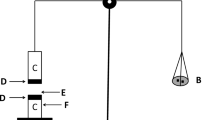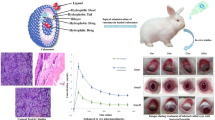Abstract
Purpose
The main goal of this study was to encapsulate Pioglitazone (PGZ), in biodegradable polymeric nanoparticles as a new strategy for the treatment of ocular inflammatory processes.
Methods
To improve their biopharmaceutical profile for the treatment of ocular inflammatory disorders, nanospheres (NSs) of PGZ were formulated by factorial design with poly (lactic-co-glycolic acid) polyethylene glycol (PLGA-PEG). Interactions drug-polymer have been carried out by spectroscopic (X-ray spectroscopy, FTIR) and thermal methods (DSC). The PGZ-NSs were tested for their in vitro release profile, cytotoxicity, and ocular tolerance (HET-CAM® test); ex vivo corneal permeation, and in vivo inflammatory prevention and bioavailability.
Results
The optimized system showed a negative surface charge of −13.9 mV, an average particle size (Zav) of around 160 nm, a polydispersity index (PI) below 0.1, and a high encapsulation efficiency (EE) of around 92%. According to the DSC results, the drug was incorporated into the NSs polymeric matrix. The drug release was sustained for up to 14 h. PGZ-NSs up to 10 μg/ml exhibited no retinoblastoma cell toxicity. The ex vivo corneal and scleral permeation profiles of PGZ-NSs showed that retention and permeation through the sclera were higher than through the cornea. Ocular tolerance in vitro and in vivo demonstrated the non-irritant character of the formulation.
Conclusion
The in vivo anti-inflammatory efficacy of developed PGZ-NSs indicates this colloidal system could constitute a new approach to prevent ocular inflammation.






Similar content being viewed by others
Abbreviations
- DSC:
-
Differential Scanning Calorimetry
- NSs:
-
Nanospheres
- PEG:
-
Polyethylene glycol
- PGZ:
-
Pioglitazone
- PI:
-
Polydispersity index
- PLGA:
-
Polylactic-co-glycolic acid
- PPARγ:
-
Peroxisome proliferator-activated receptor
- TEM:
-
Transmission electron microscopy
- ZP:
-
Zeta potential
References
Pan H, Chen J, Xu J, Chen M, Ma R. Antifibrotic effect by activation of peroxisome proliferator- activated receptor – γ in corneal fibroblasts. Mol Vis. 2009;15:2279–86.
Yamamoto A, Kakuta H, Miyachi H, Sugimoto Y. Involvement of the retinoid X receptor ligand in the anti-inflammatory effect induced by peroxisome proliferator-activated receptor agonist in vivo. PPAR Res. 2011;2011:1–8. https://doi.org/10.1155/2011/840194
Okunuki Y, Usui Y, Nakagawa H, Tajima K, Matsuda R, Ueda S, et al. Peroxisome proliferator-activated receptor-γ agonist pioglitazone suppresses experimental autoimmune uveitis. Exp Eye Res. 2013;116:291–7.
Uchiyama M, Shimizu A, Masuda Y, Nagasaka S, Fukuda Y, Takahashi H. An ophthalmic solution of a peroxisome proliferator-activated receptor gamma agonist prevents corneal inflammation in a rat alkali burn model. Mol Vis. 2013;19:2135–50.
Calvo P, Vila-Jato JL, Alonso MJ. Evaluation of cationic polymer-coated nanocapsules as ocular drug carriers. Int J Pharm. 1997;153(1):41–50.
Araújo J, Vega E, Lopes C, Egea MA, Garcia ML, Souto EB. Effect of polymer viscosity on physicochemical properties and ocular tolerance of FB-loaded PLGA nanospheres. Colloids Surf B: Biointerfaces. 2009;72(1):48–56.
Alvarado HL, Abrego G, Garduño-Ramirez ML, Clares B, Calpena AC, García ML. Design and optimization of oleanolic/ursolic acid-loaded nanoplatforms for ocular anti-inflammatory applications. Nanomed Nanotech Biol Med. 2015;11(3):521–30.
Parra A, Mallandrich M, Clares B, Egea MA, Espina M, Garcia ML, et al. Design and elaboration of freeze-dried PLGA nanoparticles for the transcorneal permeation of carprofen: Ocular anti-inflammatory applications. Colloids Surf B: Biointerfaces. 2015;136:935–43.
Fangueiro JF, Calpena AC, Clares B, Andreani T, Egea MA, Veiga FJ, et al. Biopharmaceutical evaluation of epigallocatechin gallate-loaded cationic lipid nanoparticles (EGCG-LNs): In vivo, in vitro and ex vivo studies. Int J Pharm. 2016;502(1–2):161–9.
Ramos GR, Garcia ML, Espina M, Parra A, Calpena AC. Influence of freeze-drying and γ-irradiation in preclinical studies of flurbiprofen polymeric nanoparticles for ocular delivery using d-(+)-trehalose and polyethylene glycol. Int J Nanomedicine. 2016;11:4093–106.
De Campos AM, Sánchez A, Gref R, Calvo P, Alonso MJ. The effect of a PEG versus a chitosan coating on the interaction of drug colloidal carriers with the ocular mucosa. Eur J Pharm Sci. 2003;20(1):73–81.
Danhier F, Ansorena E, Silva JM, Coco R, Le Breton A, Préat V. PLGA-based nanoparticles: An overview of biomedical applications. J Control Release. 2012;161(2):505–22.
Cañadas C, Alvarado H, Calpena AC, Silva AM, Souto EB, Garcia ML, et al. vitro, ex vivo and in vivo characterization of PLGA nanoparticles loading pranoprofen for ocular administration. Int J Pharm. 2016;511(2):719–27.
Xu Y, Effect DY. of molecular structure of chitosan on protein delivery properties of chitosan nanoparticles. Int J Pharm. 2003;250(1):215–26.
Sánchez-López E, Egea MA, Cano A, Espina M, Calpena AC, Ettcheto M, et al. PEGylated PLGA nanospheres optimized by design of experiments for ocular administration of dexibuprofen-in vitro, ex vivo and in vivo characterization. Colloids Surf B: Biointerfaces. 2016;145:241–50.
Fessi H, Puisieux F, Devissaguet JP, Ammoury N, Benita S. Nanocapsule formation by interfacial polymer deposition following solvent displacement. Int J Pharm. 1989;55(1):R1–4.
Satheeshkumar N, Shantikumar S, Srinivas R. 2014. Pioglitazone: A review of analytical methods. J Pharm Anal. 2014;4(5):295–302.
Clogston JD, Patri AK. Zeta Potential Measurement. In: McNeil SE, editor. Characterization of nanoparticles intended for drug delivery. Totowa: Humana Press; 2011. p. 63–70.
Vega E, Gamisans F, García ML, Chauvet A, Lacoulonche F, Egea MA. PLGA nanospheres for the ocular delivery of flurbiprofen: drug release and interactions. J Pharm Sci. 2008;97:5306–17.
Abrego G, Alvarado H, Souto EB, Guevara B, Bellowa LH, Parra A, et al. Biopharmaceutical profile of pranoprofen-loaded PLGA nanoparticles containing hydrogels for ocular administration. Eur J Pharm Biopharm. 2015;95:261–70.
Abrego G, Alvarado HL, Egea MA, Gonzalez-Mira E, Calpena AC, Garcia ML. Design of nanosuspensions and freeze-dried PLGA nanoparticles as a novel approach for ophthalmic delivery of pranoprofen. J Pharm Sci. 2014;103(10):3153–64.
Yamaoka K, Nakagawa T, Uno T. 1978. Application of Akaike’s information Criterion (AIC) in the evaluation of linear pharmacokinetic equations. J Pharmacokinet Biopharm. 1978;6:165–75.
Luepke NP. Hen’s egg chorioallantoic membrane test for irritation potential. Food Chem Toxicol. 1985;23(2):287–91.
Draize J, Woodard G, Calvery H. 1944. Methods for the study of irritation and toxicity of substances applied topically to the skin and mucous membranes. J Pharmacol Exp Ther. 1944;82(3):377–90.
Kay JH, Calandra JC. Interpretation of eye irritation tests. J Soc Cosmet Chem. 1962;13:281–9.
Andreani T, et al. Surface engineering of silica nanoparticles for oral insulin delivery: Characterization and cell toxicity studies. Colloids Surf B: Biointerfaces. 2014;123:916–23.
Vega E, Egea MA, Calpena AC, Espina M, García ML. Role of hydroxypropyl-B-cyclodextrin on freeze-dried and gamma-irradiated PLGA and PLGA-PEG diblock copolymer nanospheres for ophthalmic flurbiprofen delivery. Int J Nanomedicine. 2012;7:1357–71.
Prausnitz MR, Noonan JS. Permeability of cornea, sclera, and conjunctiva: a literature analysis for drug delivery to the eye. J Pharm Sci. 1998;87(12):1479–88.
Niwa T, Takeuchi H, Hino T, Kunou N, Kawashima Y. Preparations of biodegradable nanospheres of water-soluble and insoluble drugs with D,L-lactide/glycolide copolymer by a novel spontaneous emulsification solvent diffusion method, and the drug release behavior. J Control Release. 1993;25:89–98.
Resende AP, Silva B, Braz BS, Nunes T, Gonçalves L, Delgado E. Ex vivo permeation of erythropoietin through porcine conjunctiva, cornea and sclera. Drug Deliv Transl Res. 2017;7(5):625–31. https://doi.org/10.1007/s13346-017-0399-y
Nguyen TD. Biomechanics of the Cornea and Sclera. In: Kassab GS, Sacks MS, editors. Structure-Based Mechanics of Tissues and Organs [Internet]. Boston: Springer US; 2016. p. 285–315.
Araújo J, Garcia ML, Mallandrich M, Souto EB, Calpena AC. Release profile and transscleral permeation of triamcinolone acetonide loaded nanostructured lipid carriers (TA-NLC): In vitro and ex vivo studies. Nanomed Nanotech Biol Med. 2012;8(6):1034–41.
Wen HE, Hao J, Li SK. Characterization of human sclera barrier properties for transscleral delivery of bevacizumab and ranibizumab. J Pharm Sci. 2013;102(3):892–903.
Shen W, Gao Y, Lu B, Zhang Q, Hu Y, Chen Y. Negatively regulating TLR4/NF-kB signaling via PPAR in endotoxin-induced uveitis. Biochim Biophys Acta Mol Basis Dis. 2014;1842(7):1109–20.
Ronald DS, Huang HS. Corneal Penetration Behavior of β-Blocking Agents I: Physicochemical Factors. J Pharm Sci. 1983;72(11):1266–72.
Vasconcelos A, Vega E, Pérez Y, Gómara MJ, García ML, Haro I. Conjugation of cell-penetrating peptides with poly(Lactic-co-glycolic acid)-polyethylene glycol nanoparticles improves ocular drug delivery. Int J Nanomedicine. 2015;10:609–31.
Arechabala B, Coiffard C, Rivalland P, Coiffard LJM. De Roeck-Holtzhauer Y. Comparison of cytotoxicity of various surfactants tested on normal human fibroblast cultures using the neutral red test, MTT assay and LDH release. J Appl Toxicol. 1999;19(3):163–5.
Jiang Y, Thakran S, Bheemreddy R, Ye EA, He H, Walker RJ, et al. Pioglitazone normalizes insulin signaling in the diabetic rat retina through reduction in tumor necrosis factor and suppressor of cytokine signaling 3*. J Biol Chem. 2014;289(38):26395–405.
Murata T, Hata Y, Ishibashi T, Kim S, Hsueh WA, Law RE, et al. Response of experimental retinal neovascularization to thiazolidinediones. Arch Ophthalmol. 2001;119(5):709–17.
ACKNOWLEDGMENTS AND DISCLOSURES
This work has benefited from the backing of the Spanish Ministry of Science and Innovation (MAT2014-59134R). The authors would like to acknowledge Lidia Gómez Segura for her help with the in vivo study. Ms. Marcelle Silva de Abreu acknowledges the positive contribution of the Coordination for the Improvement of Higher Education Personnel (CAPES) - Brazil for the PhD scholarship.
Author information
Authors and Affiliations
Corresponding author
Electronic Supplementary Material
ESM 1
(DOCX 2530 kb)
Rights and permissions
About this article
Cite this article
Silva-Abreu, M., Calpena, A.C., Espina, M. et al. Optimization, Biopharmaceutical Profile and Therapeutic Efficacy of Pioglitazone-loaded PLGA-PEG Nanospheres as a Novel Strategy for Ocular Inflammatory Disorders. Pharm Res 35, 11 (2018). https://doi.org/10.1007/s11095-017-2319-8
Received:
Accepted:
Published:
DOI: https://doi.org/10.1007/s11095-017-2319-8




